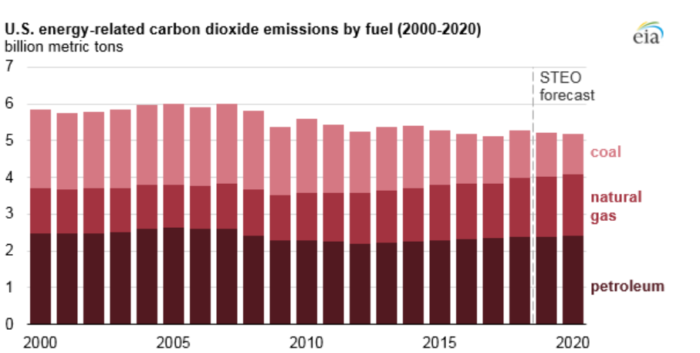EIA recently published a ‘Short-Term Energy Outlook’, according to which energy-related CO2 emissions rose by 2.8% in 2018 but are expected to decrease in 2019 and 2020. Yet, 2018 is the largest energy related CO2 emissions since 2010.
Mainly, despite the fact that emissions from petroleum, that commonly account for the majority of total CO2, emissions from natural gas on the other hand rose by 10%, driving the overall increase in 2018.
Also, weather conditions and a continuous economic development were basic factors in increasing energy consumption and emissions in 2018.
Based on EIA, the overall US consumption in 20178 will be 0.4% below the record of 2017.
[smlsubform prepend=”GET THE SAFETY4SEA IN YOUR INBOX!” showname=false emailtxt=”” emailholder=”Enter your email address” showsubmit=true submittxt=”Submit” jsthanks=false thankyou=”Thank you for subscribing to our mailing list”]
High energy consumption is due to the weather conditions. In other words, last year was very warm and US population weighted cooling degree days (CDD, an indicator of air-conditioning demand) hit a new record in 2018.
In addition, during winter the US experienced cold weather in comparison to the last ten years, so heating degree days were the highest since 2014.
These patterns resulted to what EIA reports as record levels of electricity consumption and natural gas consumption in 2018. Electricity is used to meet virtually all air conditioning demand, and natural gas and electricity are the two most common heating fuels.
According to EIA, 2019 and 2020 are expected to have milder weather conditions in comparison to 2018, resulting to less energy consumption.
Yet, even with reduction in emissions over the next two years, energy-related CO2 emissions in 2019 and 2020 are still projected to be higher than 2017 levels.
Gross domestic product growth slows from 2.9% in 2018 to 2.7% in 2019, to 2.0% in 2020.
In conclusion, EIA estimates industrial production development to have been 1% more than GDP growth in 2018.
Also, industrial production is expected to grow faster than GDP in 2019 but slower than GDP in 2020. The effect of industrial growth on emissions in 2019 is more than offset by a forecast return to more normal weather.
Slower growth in industrial production in 2020 is to decrease the energy and carbon intensity associated with GDP growth, as industrial production tends to be more energy intensive than other parts of the economy.




























































